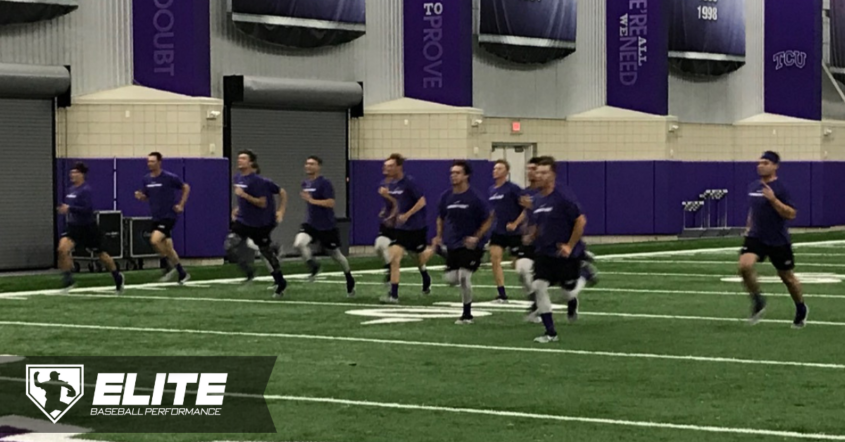Proper Conditioning for the Baseball Player
Conditioning with Tempo Runs
Conditioning for baseball players has long consisted of LSD: long, slow, distance work.
While slow aerobic work has it benefits, I tend to disagree that it is a useful technique for baseball athletes which leads up to the inclusion of tempo runs. Tempo runs tend to fill the gap between speed, aerobic fitness, and recovery.
Tempo runs are low intensity sprints performed at 65-75% of max speed. They are essentially the middle ground between full out sprints, and slow jogging.
They are termed such by the great Canadian sprint coach Charlie Francis. He utilized tempo runs as not only a form of aerobic development for sprinters but as a means of recovery in his high / low system of programming.
A high-low system, if you are unaware, means high nervous system intensive demands are all placed on one day, followed by low nervous system demands the following day.
Using this format allows for greater recovery in preparation for the next high training day. Speed, strength, and power are all highly dependent upon the neuromuscular system, or the CNS.
Training high-intensity elements on back-to-back days constantly creates CNS fatigue and disrupts the body’s ability to produce at a high output.
High CNS means are prioritized with at least 48 hours of recovery before they should be trained again. The rest gives the neuromuscular system time to rebound. Fatigue doesn’t bode well for developing speed, strength, or power.
CNS Recovery
Tempo runs are an excellent means of recovery work on low intensity days. Staying in the 65%-75% of max speed is essential for nervous system recovery.
The high / low system is focused on eliminating the middle ground of sprinting at 76-95% intensities. These intensities are too slow to be utilized for speed development, and too fast for recovery. They become too intensive to recover from quickly and create residual fatigue for the next high intensive day.
When that happens, the main work, such as strength, power, and speed suffers. Tempo runs give athletes a more specific training effect without substantial nervous system fatigue.
Speed technique
Speed and power athletes can benefit from tempo runs due to its specificity. Tempo runs allow athletes to focus on some of the technical pieces important to high level sprinting. Athletes can focus on arm drive, relaxation, and rhythm in a submaximal setting when performing high volumes of tempo runs.
A cue I use often is to pretend as if you’re Usain Bolt in the early rounds of the 100m, cruising to a victory 20m ahead of the pack. Run easy, relaxed, and rhythmical.
Aerobic development
Baseball has long been a slave to the belief that pitching is built around a foundation of aerobic capacity. Long, slow, jogging and distance work is not specific, nor is it complementary to speed, and power development.
Too much slow work interferes with gains on the other end of the spectrum. Tempo runs give athletes the benefits of cardiovascular development in a more complimentary fashion to the rest of their training.
While the aerobic system is important and necessary it must also be understood that it isn’t the end all be all. Where the aerobic energy system is important is in the parasympathetic nervous system and in recovery process of the body.
Capillary Density
One of the biggest benefits in that of increasing capillary density. Low intensity tempo runs build a larger capillary network throughout the muscle. Increasing capillary density provides many benefits.
Staying Warmer
Increasing capillary density creates more heat throughout the muscle as well as allows for the muscle to stay warmer longer.
This was hugely important for Olympic level sprinters as often their training runs would require 10-20 minutes of rest to insure full recovery.
The ability to stay warm was key. With baseball, this is an absolute no-brainer. Position players may easily stand around for long periods of time without moving.
Enhancing capillary density can help keep athletes warmer when the time comes for that one all out sprint effort following 20+ minutes of waiting in the outfield for a ball to come your way.
Blood Flow and Nutrient Transfer
Enhanced capillary density improves blood flow throughout the muscle complex.
Increasing blood flow not only enhances heat, but also improves oxygenation, as well as nutrient transfer.
Nutrient transfer is important in not only the benefits of more nutrient availability on the good side but also the removal of waste products on the bad side.
Implementation
I prefer a walking rest interval during our tempo runs. This is generally a 1:2 ratio.
Take the distance of each rep and walk half that between each run. If athletes are doing 100yd tempo runs, I have them walk to the 25yd line and back for their rest interval.
Intensity
The intensity is the most important element with tempo runs. Athletes should stay within 65-75% of maximum speed.
Calculations can be made based upon an athlete’s best 60m time or other sprint time, but I find it unnecessary to do a bunch of calculations. Rather, I rely on the athletes to determine their own 65-75%.
Not only does this give them awareness of their own movement, but they will drift towards their current readiness levels as well. A more tired athlete will run slower than a fresh athlete, which is fine.
If a coach does base it off a best time remember to factor in the conditions of where the best time was performed versus where the tempo runs are happening (track vs grass field).
The best indicator of proper intensity is an athlete should be able to perform the first rep and the last rep at the same intensity. An athlete running too fast will begin to fatigue and the last reps will be slower and more tiring than the first.
Tempo runs should be almost refreshing to the body. Fatigue should not be a large factor.
Total Volume
The total volume often depends on goals but I often stay between 1000-1600 total yards of volume.
At times, we may work up close to 2000 yards but that is few and far between. Charlie Francis used 2000 yards as his standard for 100m sprinters.
Coaches should build volume gradually just as they would with any other new stimulus.
Each run varies from 50-100 yards but any variety of distances can be effective.
Location
In general tempo runs should be performed on a softer surface. Grass makes for the best surface to eliminate repetitive pounding that baseball athletes may not be used to.
Tempo Example:
14 runs of 80 yards with a 40-yard walk rest interval
Implementing tempo runs into a baseball program can not only enhance the cardiovascular system that so many coaches believe in, but also assist in the recovery processes and speed development.
Baseball is a speed/power sport and training athletes to the match the demands of competition should be a priority. Long distance running doesn’t fit the mechanical, nor physiological requirements of the sport.
Adding tempo runs can complement the explosive sport demands while also assisting those of aerobic development, and recovery.
Zach Dechant
Zach graduated with a Bachelor’s Degree in Health and Wellness from Missouri State University in 2003, and is currently working towards his Master’s Degree. He is certified through the NSCA, CSCCA, FMS, and USA-W.
During the off-seasons, Zach trains a large group of 25+ professional baseball players from across all levels of play as well as athletes from the NFL.
Latest posts by Zach Dechant (see all)
- Regaining Shoulder Range of Motion in Baseball Players - January 15, 2019
- Proper Conditioning for the Baseball Player - October 30, 2018
- Acute to Chronic Workload Ratios in Baseball - March 6, 2018











Great insights on the importance of conditioning for baseball players! I especially appreciated the emphasis on specific drills designed for agility and strength. It’s clear that proper conditioning can make a huge difference on the field. Looking forward to implementing some of these techniques in my training!
Great insights on conditioning for baseball players! I appreciate the emphasis on sport-specific movements and the importance of injury prevention. It’s refreshing to see a focus on building not just strength, but also agility and endurance for the game. Looking forward to trying out some of these drills!
Great insights on conditioning for baseball players! I love how you emphasized the importance of tailoring workouts to specific positions. It’s crucial for maximizing performance on the field. Looking forward to implementing some of these strategies in my training!
Great insights on conditioning for baseball players! I particularly appreciated the emphasis on agility and strength training tailored for the sport. It’s fascinating how proper conditioning can significantly enhance performance on the field. Looking forward to incorporating these strategies into my training routine!
Great insights on conditioning! I appreciate the emphasis on sport-specific training for baseball players. It’s refreshing to see a focus on both physical and mental aspects of performance. Can’t wait to implement some of these techniques in my own routine!
Great insights on conditioning for baseball players! I appreciate how you emphasized the importance of both strength and agility training. It’s crucial for athletes to focus on functional movements to enhance performance on the field. Looking forward to implementing these tips!